
Japan International Experience 2016: The Shinkansen Waits for No One
In March, Yale MBA students traveled to various locations as part of the International Experience course. The course begins with a half semester of classroom study and culminates with a 10-day trip to one or more business capitals. Chris Wearn '17 reflects on the International Experience to Japan.
Trip Themes:
Imagine yourself as the CEO of a Japanese energy company. In a culture influenced by pride and shame, how would you apologize for a nuclear disaster that changed your country, while respecting both the victims and your co-workers? As a public policy manager, how would you plot a course to engage more women in an aging workforce, while simultaneously hoping to boost birth rates? As a visitor, how can we understand cultural experiences that range from time-honored traditions (including historic castles, Kabuki theater, and the sacred sport of Sumo) to new-age activities (like robot restaurants, electronic clubs, and high speed trains)?
We explored these questions, and more, across two weeks in a country shaped equally by a respect for tradition and the past, as by a drive toward progress, technology, and the future.
Pre-Trip Activities
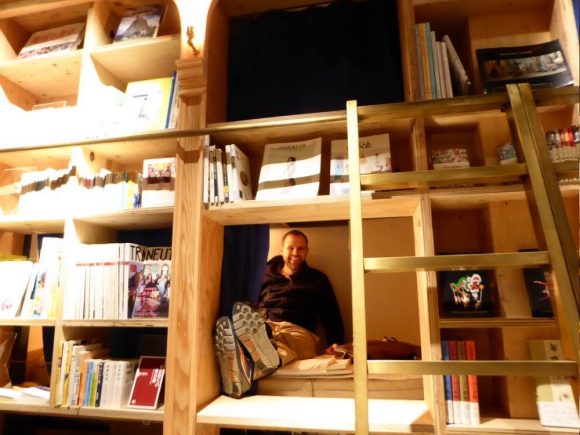
Judy and my first purchase after we landed in Tokyo was a Sake juice box from 7-Eleven and an Onigiri ball (a small sushi burrito). It might not have been our best meal, but it provided an exciting reminder that we had come to a very different place. Vending machines lined literally every street corner, nobody ever jaywalked, and few people spoke English. Space was so valuable that our hostel built capsule beds into bookshelves and sold them as “standard rooms.”
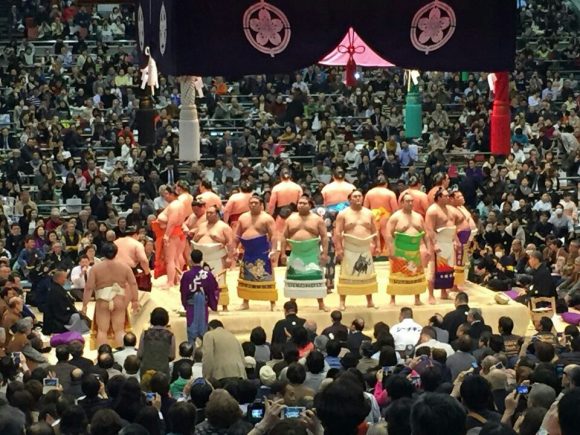
Like most folks, I flew in a few days early, suffering 25-hour itineraries on Chinese airlines through Shanghai, to save a few hundred dollars. When we gathered as a group in Tokyo on Tuesday night, we shared stories from different pre-trip adventures. Many had journeyed to Osaka to watch Sumo wrestling. Others had journeyed to Kyoto to see the bamboo forests and shrines, while others had traveled throughout South East Asia.
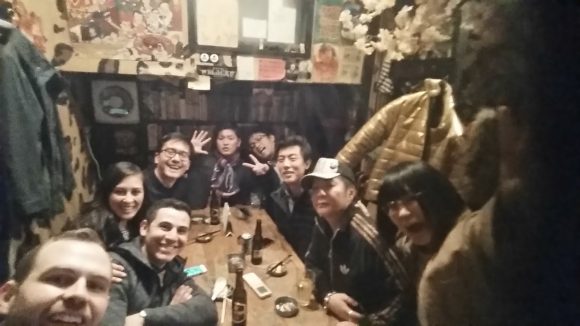
That night many of us wandered to Golden Gai, a neighborhood of micro bars. We shared drinks at Kenzo’s—a one-table bar that served traditional tofu appetizers between each round. The drink choices were limited, the room was smoky, and the charismatic owner drank with us, wearing golden shoes and a golden jacket that said “Blood Money Tokyo.” He even shared posters with us from his successful campaign for a local political position. Kenzo’s was not easy to find and charged a small cover, but was well worth the price of admission.
Wednesday, March 16

We spent the day in the Keio Plaza hotel, where we were joined by presenters from the Japanese business world. We heard about the challenges of maintaining Japan’s Kiertsu business practices (based on long-term, loyal, supply chain relationships) in a country where natural disasters can often wreak havoc on any single geographic area.
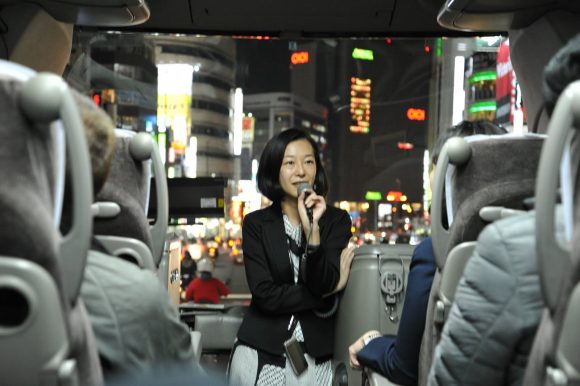
We also learned about Japan’s challenges to build more diversity into the workforce in a country where foreigners make up less than 2% of the populace. We also heard from TEPCO CEO and SOM alumnus, Naomi Hirose (pictured, right), who spoke from the heart about the Fukashima nuclear accident, the cleanup efforts, and the future direction of TEPCO.
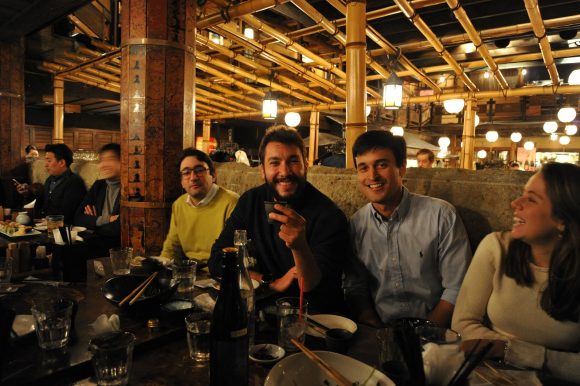
That evening we met our incredible guide for the trip, Reiko, who won our hearts over the next two weeks. “Reiko was beyond amazing. Her knowledge about local sites, culture, and Japanese history were incredible. She was not only a great guide, but also truly warm and friendly. Our IE wouldn’t have been the same without her!”- Judy
The day was capped off by a group dinner at Gompachi, a restaurant in the hip Shibuya district, rumored to be the setting of the movie Kill Bill’s most iconic battle.
Thursday, March 17
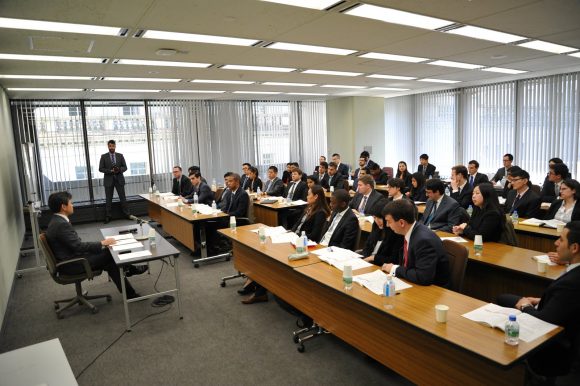
Our group visited the Bank of Japan (BOJ; Japan’s Central Bank). With the world watching Japan step into an unprecedented frontier of monetary policy, we had the chance to ask questions first hand of one of their directors. “We learned that the BOJ is seeking to incentivize Japanese private banks to loosen lending policies and provide additional financing to the market by instituting negative interest rates for the very first time. They are charging Japanese private banks to house excess funds with the BOJ. It remains to be seen how the financial markets will respond, whether it will achieve the stated goal of promoting investment and economic growth.”- Cole
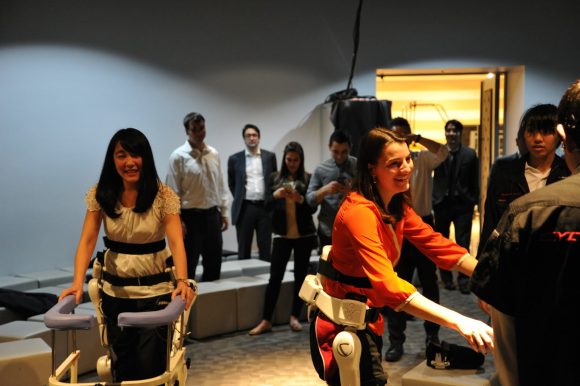
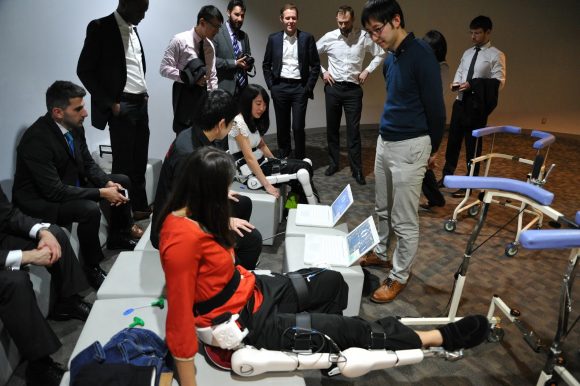 That afternoon, some of us headed to Cyberdine, a technology company making automated, robotic exoskeletons to aid rehabilitation patients. Judy and Michelle had a chance to try the suits on.“Wearing the robot suit was super fun. My legs were covered in EKG sensors that enabled the electrical signals from my muscles to be transmitted to the suit, which would amplify those same movements. I definitely got a sense of how the suit would help guide my legs if I had difficulty moving one or both of both of them”-Judy
That afternoon, some of us headed to Cyberdine, a technology company making automated, robotic exoskeletons to aid rehabilitation patients. Judy and Michelle had a chance to try the suits on.“Wearing the robot suit was super fun. My legs were covered in EKG sensors that enabled the electrical signals from my muscles to be transmitted to the suit, which would amplify those same movements. I definitely got a sense of how the suit would help guide my legs if I had difficulty moving one or both of both of them”-Judy
That night, we headed to a robot restaurant for a show featuring music, dancing, and automated robots fighting to save the world.
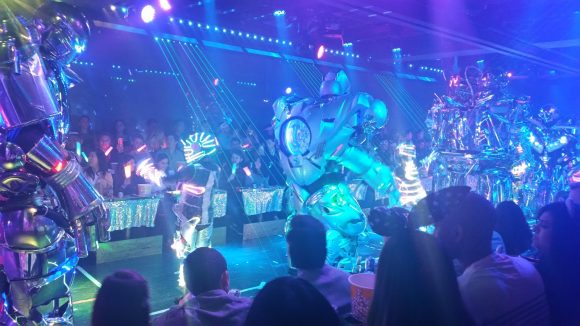
Friday, March 18
 We visited TESSEI, a company famous for its Seven Minute Miracle, cleaning 1,500-person high-speed trains, from top to bottom in seven minutes. They are also known for their remarkable corporate turnaround after reconstructing their cleaning jobs into hospitality roles (now the subject of a famous HBS case). “JR Tessei impressed me as we watched the staff turn around a whole train at Tokyo station in actually less than seven minutes. Employees sprinted through every car in order to make sure that the train left on time.”- Johann
We visited TESSEI, a company famous for its Seven Minute Miracle, cleaning 1,500-person high-speed trains, from top to bottom in seven minutes. They are also known for their remarkable corporate turnaround after reconstructing their cleaning jobs into hospitality roles (now the subject of a famous HBS case). “JR Tessei impressed me as we watched the staff turn around a whole train at Tokyo station in actually less than seven minutes. Employees sprinted through every car in order to make sure that the train left on time.”- Johann
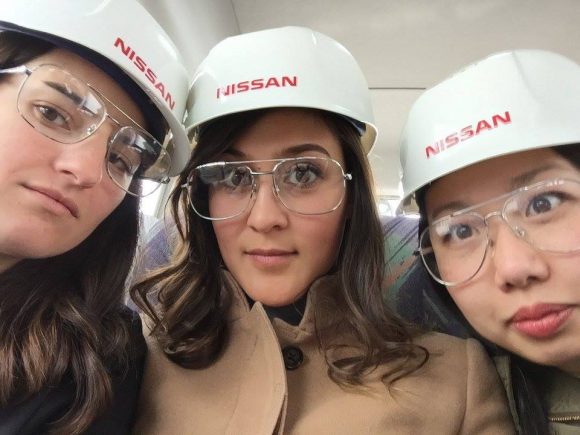 That afternoon we visited a Nissan factory. Here we saw Kaizen in action, along with Ando, Kanban, and Automated Guided Vehicles. We learned about their new pull-based supply chain, where unique, customized customer orders from dealership drive the production process.
That afternoon we visited a Nissan factory. Here we saw Kaizen in action, along with Ando, Kanban, and Automated Guided Vehicles. We learned about their new pull-based supply chain, where unique, customized customer orders from dealership drive the production process.
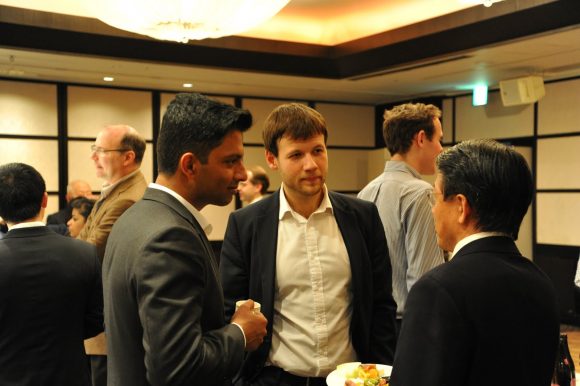 That night we joined Yale alumni living and working in Tokyo for a reception. Some of those alumni joined us for karaoke afterward, along with CDO director Julia Zupko. “I was surprised mostly by how enthusiastic everyone was about participating in singing new and old hits. I particularly loved that a few alumni from the reception decided to join us for the experience!”- Lisa (seen below in front)
That night we joined Yale alumni living and working in Tokyo for a reception. Some of those alumni joined us for karaoke afterward, along with CDO director Julia Zupko. “I was surprised mostly by how enthusiastic everyone was about participating in singing new and old hits. I particularly loved that a few alumni from the reception decided to join us for the experience!”- Lisa (seen below in front)
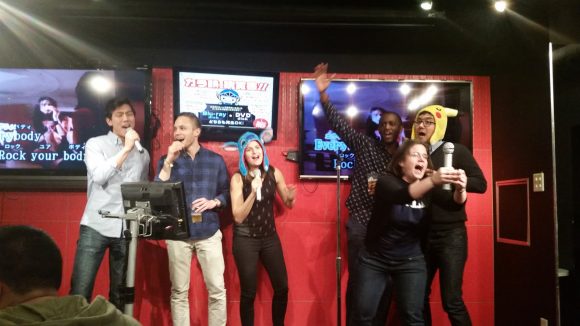
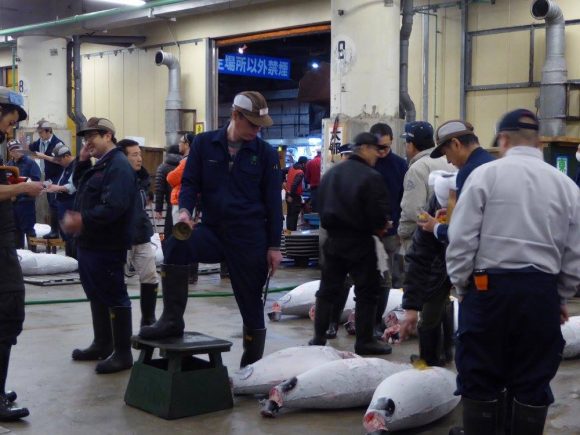 Following karaoke, some of us headed to a club in downtown Tokyo, and were lucky enough to be joined by both our professors. The club started winding down at 2:30 a.m., which is just about the time that crowds started gathering at the legendary Tokyo fish market to catch a glimpse of the early morning wholesale trading and tuna auction. Only 100 or so tourists are allowed to watch the fun each day, so I joined up with Priyanka, Lisa, Judy, and Julia straight from the club to get in line. After a few hours in line, we were invited into the middle of the market, where restaurants, distributors, and sushi chefs battle to bring home the best fish.
Following karaoke, some of us headed to a club in downtown Tokyo, and were lucky enough to be joined by both our professors. The club started winding down at 2:30 a.m., which is just about the time that crowds started gathering at the legendary Tokyo fish market to catch a glimpse of the early morning wholesale trading and tuna auction. Only 100 or so tourists are allowed to watch the fun each day, so I joined up with Priyanka, Lisa, Judy, and Julia straight from the club to get in line. After a few hours in line, we were invited into the middle of the market, where restaurants, distributors, and sushi chefs battle to bring home the best fish.
Saturday and Sunday
 The weekend gave everyone a chance to choose their own adventure. On Saturday, one group took a tour of Tokyo, while another headed to see a traditional Kabuki performance. “Kabuki theater was a great cultural experience—Japanese version of Broadway!”-Bernier
The weekend gave everyone a chance to choose their own adventure. On Saturday, one group took a tour of Tokyo, while another headed to see a traditional Kabuki performance. “Kabuki theater was a great cultural experience—Japanese version of Broadway!”-Bernier
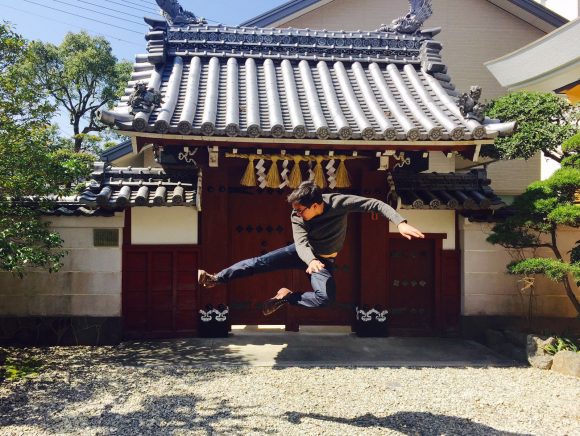 On Sunday, one group went to the Ise Jingu shine, while another visited Kyoto. “I wanted to eat everything I could in Kyoto. The Nishiki Market is a magical place with magical smells. Who knew a fish cake stuffed with octopus could taste so good?”- Jen.
On Sunday, one group went to the Ise Jingu shine, while another visited Kyoto. “I wanted to eat everything I could in Kyoto. The Nishiki Market is a magical place with magical smells. Who knew a fish cake stuffed with octopus could taste so good?”- Jen.
A third group visited a Japanese Onsen. “The Japanese Onsen was an experience unlike any other! There were so many different hot springs and mineral baths to choose from it felt like a spa amusement park. The Onsen was also a nice way to immerse ourselves into the Japanese culture and relax from all the company visits!”- Kristine.

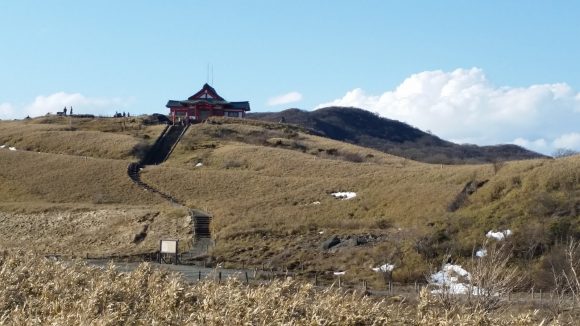 As for myself, after four days in the world’s largest city, I was craving a bit of the wilderness. I headed south to Hakone National Park, in search of good hiking and a view of Mt. Fuji. I was lucky to find both, and discovered the wonderful mountain town of Miyanoshita along the way.
As for myself, after four days in the world’s largest city, I was craving a bit of the wilderness. I headed south to Hakone National Park, in search of good hiking and a view of Mt. Fuji. I was lucky to find both, and discovered the wonderful mountain town of Miyanoshita along the way.
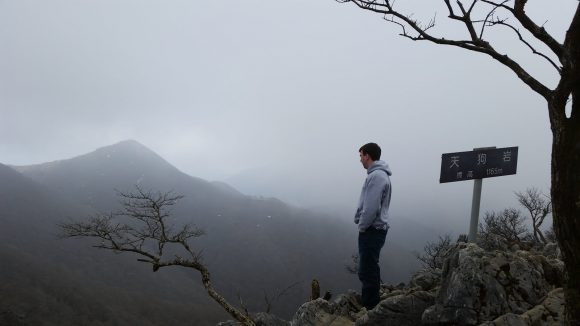 On Sunday I headed north, joined by Kevin for a hike in the Hida Mountains, or “Japanese Alps.” Perhaps most surprising to me was the sheer number of “silver-age citizens” (as they are known in Japan) on the trails. Even 4 miles in and 4,000 vertical feet up from the trailhead, most of the hikers I saw were well into retirement age and many were moving faster than me. It is no wonder Japan ranks #3 in the world for longevity (the U.S. ranks #63).
On Sunday I headed north, joined by Kevin for a hike in the Hida Mountains, or “Japanese Alps.” Perhaps most surprising to me was the sheer number of “silver-age citizens” (as they are known in Japan) on the trails. Even 4 miles in and 4,000 vertical feet up from the trailhead, most of the hikers I saw were well into retirement age and many were moving faster than me. It is no wonder Japan ranks #3 in the world for longevity (the U.S. ranks #63).
Monday, March 21
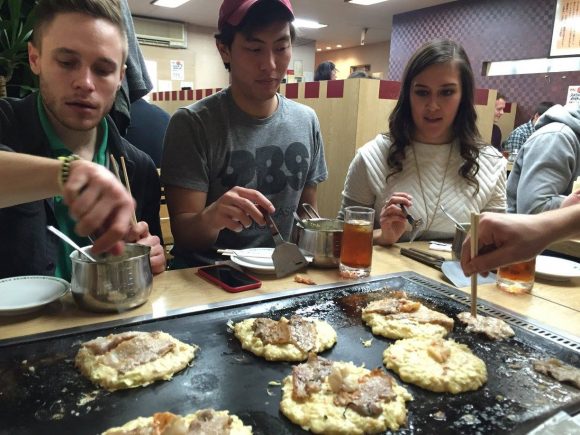 Vernal Equinox Day in Japan, a celebration of nature and living things. Businesses were closed, which gave us a chance to enjoy some cultural activities led by Reiko. Our day began in Nagoya, but we traveled by Shinkansen (high-speed “bullet train”) to Osaka. We visited a local market, made our own Okonomiyaki lunch, and visited Osaka Castle.
Vernal Equinox Day in Japan, a celebration of nature and living things. Businesses were closed, which gave us a chance to enjoy some cultural activities led by Reiko. Our day began in Nagoya, but we traveled by Shinkansen (high-speed “bullet train”) to Osaka. We visited a local market, made our own Okonomiyaki lunch, and visited Osaka Castle.  Eight stories high, and built in 1583, the castle contains much of the history of Osaka. “I think my favorite part of Monday was the castle. Of course, the view from the top was enough to justify the visit, but it also gave me a chance to see the contrast between modern Japan and what it used to be from an architectural perspective. The green tea ice cream sold outside the castle definitely added to the experience”-Reshmi
Eight stories high, and built in 1583, the castle contains much of the history of Osaka. “I think my favorite part of Monday was the castle. Of course, the view from the top was enough to justify the visit, but it also gave me a chance to see the contrast between modern Japan and what it used to be from an architectural perspective. The green tea ice cream sold outside the castle definitely added to the experience”-Reshmi
We finished the day with a visit to the Ashai brewery. True to both Japanese hospitality and efficiency, we were invited to sample three different pints for free, but had only 20 minutes to do so. We drank fast as multiple groups moved through the tour each hour, all running precisely on time.
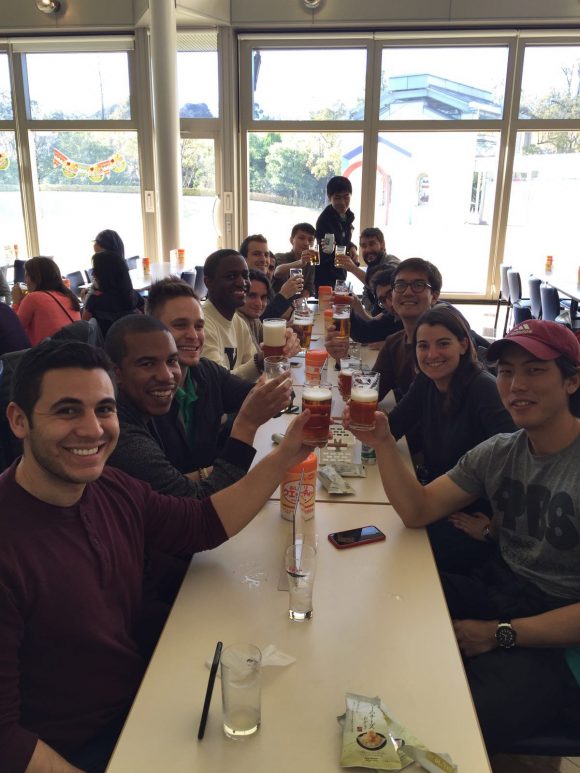
Tuesday, March 22
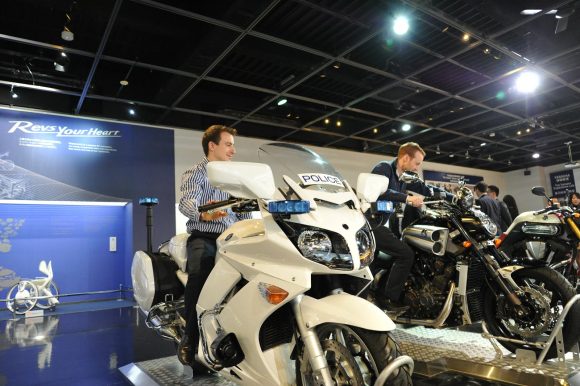 We visited two Yamaha factories, one that builds motorcycles and another that builds pianos. At the motor cycle plant we saw prototypes of Yamaha’s newest technologies from ATVs, to wheelchairs, to three-wheeled motorcycles—all supporting their vision of Kando (or thrill of life). We also saw their production lines where motorcycles moved through impeccably precise automated assembly lines, while other small batch motorcycles were build from the ground up by just two workers, both masters of their trade.
We visited two Yamaha factories, one that builds motorcycles and another that builds pianos. At the motor cycle plant we saw prototypes of Yamaha’s newest technologies from ATVs, to wheelchairs, to three-wheeled motorcycles—all supporting their vision of Kando (or thrill of life). We also saw their production lines where motorcycles moved through impeccably precise automated assembly lines, while other small batch motorcycles were build from the ground up by just two workers, both masters of their trade.
 The piano factory gave us a chance to see assembly line automation merged seamlessly with handmade craftsmanship. Pianos valued at $25,000 moved from machine-automated steps to human hands several times. We learned that there are certain things machines will never do as well humans, like the final tuning, which is always done by ear, or the construction of the highest-end pianos, which is done by a master’s hand from the ground up. Michelle had a chance to play one of the pianos and said the experience was truly amazing.
The piano factory gave us a chance to see assembly line automation merged seamlessly with handmade craftsmanship. Pianos valued at $25,000 moved from machine-automated steps to human hands several times. We learned that there are certain things machines will never do as well humans, like the final tuning, which is always done by ear, or the construction of the highest-end pianos, which is done by a master’s hand from the ground up. Michelle had a chance to play one of the pianos and said the experience was truly amazing.
Wednesday, March 23
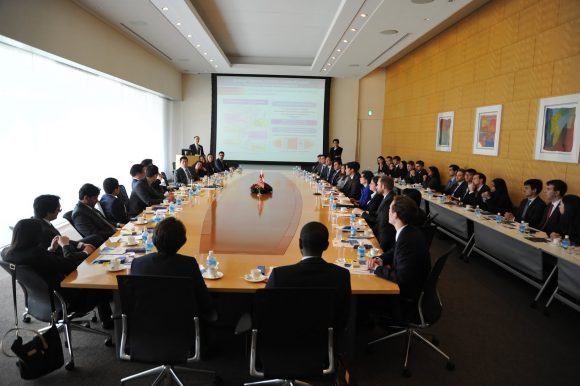 We returned to Tokyo for two last visits: one to Panasonic and one to Rakuten. Panasonic shared with us their vision for smart cities, a vision they have already realized with their Fujiwasa Sustainable Smart Town of 1,000 homes outside of Tokyo. They showed us a model smart home, complete with an Artificial Intelligence personal assistant, mirrors that show you makeup and clothing suggestions, and refrigerators that plan meals.
We returned to Tokyo for two last visits: one to Panasonic and one to Rakuten. Panasonic shared with us their vision for smart cities, a vision they have already realized with their Fujiwasa Sustainable Smart Town of 1,000 homes outside of Tokyo. They showed us a model smart home, complete with an Artificial Intelligence personal assistant, mirrors that show you makeup and clothing suggestions, and refrigerators that plan meals.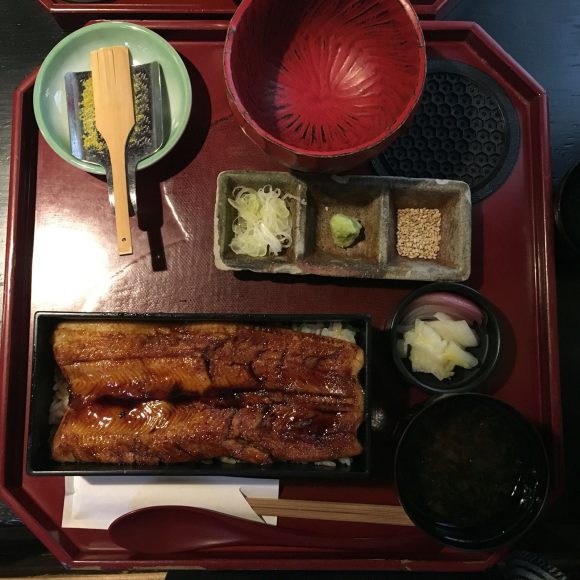 At Rakuten we saw a business model similar to U.S. tech firms: English is the official company language, and their office included massage rooms, laundry services, and a subsidized cafeteria. We learned how machine learning and artificial intelligence is at the center of their drive to create a better customer experience.
At Rakuten we saw a business model similar to U.S. tech firms: English is the official company language, and their office included massage rooms, laundry services, and a subsidized cafeteria. We learned how machine learning and artificial intelligence is at the center of their drive to create a better customer experience.
Our group shared a last traditional meal at Kagari Restaurant in the Keio Plaza Hotel. We shared Sake, relived favorite moments from the past 10 days, and shared plans for our last few days in the country.
Post Trip Adventures
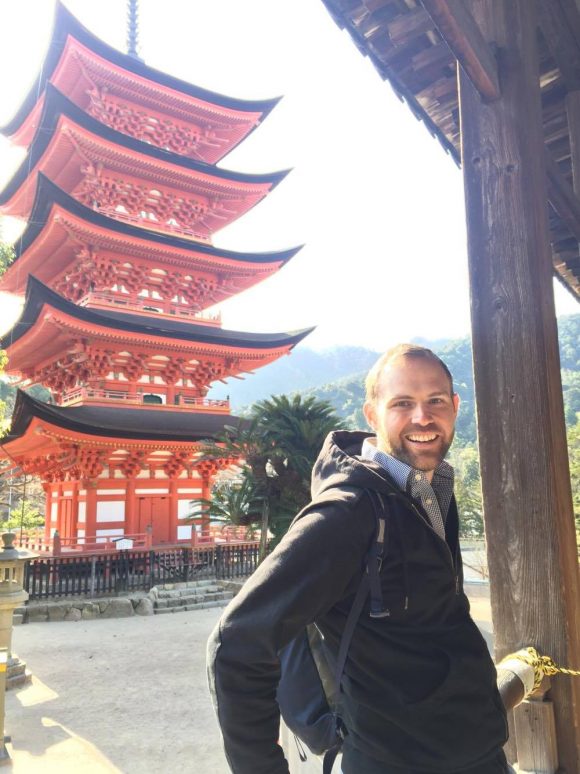 As the official trip came to a close several of us headed off for a last round of adventures. Some headed to the mountains to soak in hot springs, some stayed in Tokyo, and I headed west to Hiroshima. Priyanka had organized a post-trip itinerary there and invited any interested folks to join. On the way, Judy, Lisa, and I stopped at the famous Himeji Castle as well as the stunning Korakuen Japanese Gardens in Okayama.
As the official trip came to a close several of us headed off for a last round of adventures. Some headed to the mountains to soak in hot springs, some stayed in Tokyo, and I headed west to Hiroshima. Priyanka had organized a post-trip itinerary there and invited any interested folks to join. On the way, Judy, Lisa, and I stopped at the famous Himeji Castle as well as the stunning Korakuen Japanese Gardens in Okayama.
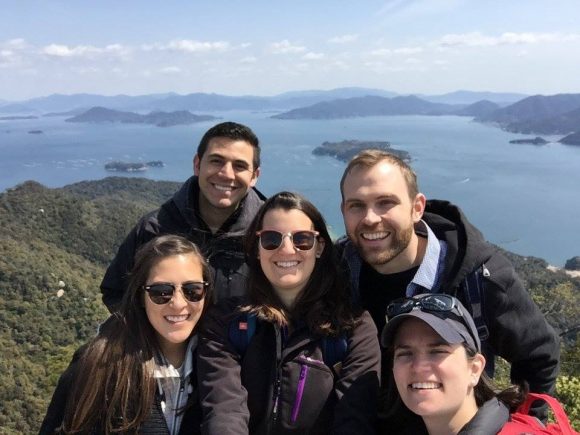 From Hiroshima, we took a ferry to nearby Miyajima Island. We visited the famous floating shrine, walked through temples overlooking the sea, and met deer that had no fear of humans. We also took a cable car halfway to the summit of Mt. Misen and hiked the rest the rest of the way. From the top we looked out over the entire Aki-nada inland sea and dozens of Japan’s southwest islands.
From Hiroshima, we took a ferry to nearby Miyajima Island. We visited the famous floating shrine, walked through temples overlooking the sea, and met deer that had no fear of humans. We also took a cable car halfway to the summit of Mt. Misen and hiked the rest the rest of the way. From the top we looked out over the entire Aki-nada inland sea and dozens of Japan’s southwest islands.
We also visited the atomic bomb memorial in Hiroshima—a sobering reminder of the destructive power of war. In visiting the museum, memorial, and atomic dome, it was inspiring to see how the city has moved forward. Hiroshima is now a global source of activism for peace and nuclear disarmament. None of the language or exhibits showed resentment toward America, only a desire to honor the 300,000-plus victims of the bomb and a strong will to move forward toward building a better world in the future. "The preserved remains from the atomic bomb memorial at Hiroshima imbued an intense sense of reverence for the lives lost, and communicated a powerfully different view to the typical American perspective."- Kevin
Following Hiroshima, I hustled back to Tokyo for my flight, while others headed to the famous hot springs in the town of Kinosaki.
Leaving
It was a whirlwind two weeks. Like most of my classmates, I had ridden over a dozen Shinkansen trains, traveling over 3,800 kilometers inside Japan in two weeks (equivalent to road tripping from Miami to New York and back). Returning from the trip, I felt lucky for all the adventures we had. The experience was a blast, and the perspectives I gained will stay with me for some time. The chance to learn from a country facing challenges around space, technology, deflation, demography, diversity, and sustainability was a sneak peek into the challenges we all will face in the years to come, as we strive to serve as leaders for business and society throughout the world.
